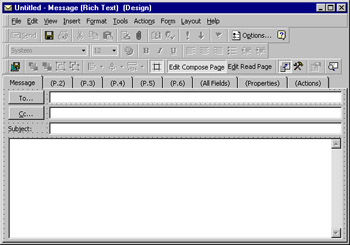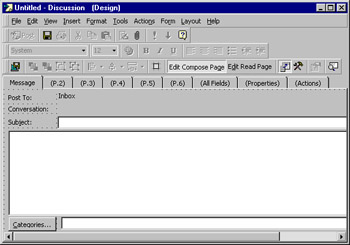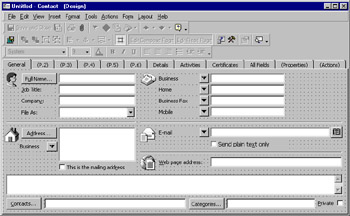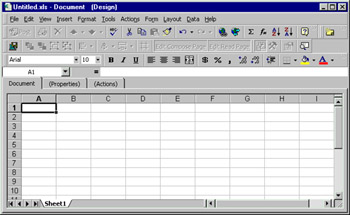Outlook Form Types
Before we look at the types of applications you can develop and when to customize certain forms in the Outlook environment, you need to know what the form types are and how they can be extended.
Message Forms
You use the Message form for applications in which users have to send information to other users, to a folder, or to another application for processing. You inherit all built-in capabilities of the form, such as automatic name resolution and nickname support, and you can customize any fields on the form. Figure 4-1 shows an example of a Message form in design mode. You can display different pages of the form by clicking on the appropriate tab.

Figure 4-1: The Message form in design mode
Post Forms
The Post form is best used in applications that post or retrieve messages in an Outlook folder. When you customize a Post form, Outlook automatically assigns the currently open Outlook folder to the In Folder field. For example, if you customize a Post form in a helpdesk public folder, Outlook automatically assigns the helpdesk public folder to the In Folder field. This automatic assignment means that even though the user can install, or publish, the Post form in any folder, any items the user creates with the form will be posted to the helpdesk public folder. Figure 4-2 shows the Post form.

Figure 4-2: The Post form in design mode
Contact Forms
Use the Contact form in applications that track address or customer information. You can customize the first page of the Contact form; you thereby inherit the form's journaling, mapping, Microsoft NetMeeting, and address resolution capabilities. The other default pages in the form are not customizable but can be hidden. Figure 4-3 shows the Contact form.

Figure 4-3: The Contact form in design mode
| Note | You can customize a number of other Outlook forms, including the Appointment, Task, and Journal forms, by hiding them or adding new pages to them. However, you cannot customize any of the built-in pages of these forms. Also, any custom applications you develop using the Journal form will post information to a user's personal journal. |
Office Document Forms
Outlook supports embedding Microsoft Word, Excel, and PowerPoint documents directly into a form, so you can send these documents to a user or post them to a folder. These types of forms are best used when you want the advanced replication and forms library support of Outlook but you also want the functionality of other Office applications. Outlook places a wrapper around the Office application you use to design the form, so you cannot add custom tabs to the form. You can, however, customize the application by using the built-in capabilities and tools provided by the specific Office application. For example, you can use VBA to customize an Outlook Office document form. Figure 4-4 shows an Excel Office document form.

Figure 4-4: An Excel Office document form in design mode
| Note | Office document forms are no longer available in Outlook 2002 and later. If you want to build Office document forms, you have to use a previous version of Outlook, such as Outlook 2000. Any Office document forms you build will run in Outlook 2002 and Outlook 2003. |
EAN: 2147483647
Pages: 227